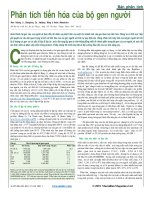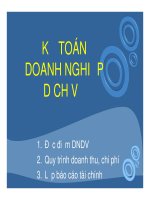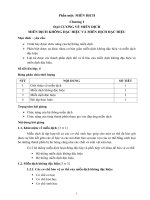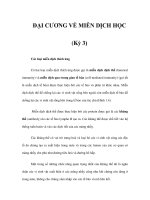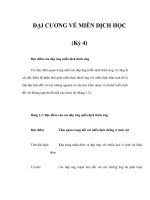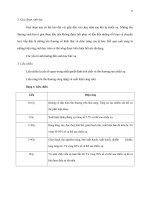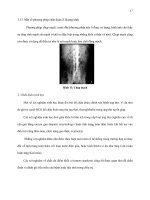Dịch dai cuong EN42 016
Bạn đang xem bản rút gọn của tài liệu. Xem và tải ngay bản đầy đủ của tài liệu tại đây (173.13 KB, 29 trang )
DỊCH ĐẠI CƯƠNG- EN42
Bài luyện tập trắc nghiệm 01
1. The predominant purpose of theories of translation is ………… of every word and phrase in the
original.
a. To do a lot of translating
b. to express as exactly as possible the full force and meaning Câu trả lời đúng
c. To get as many meanings as possible
d. To do a good job
2. In the other theory of translation, the predominant purpose is……… , but rather moves in its
new dress with the same ease as in its native rendering.
a. to produce a result that does not read like a translation at all Câu trả lời đúng
b. To replace the new text with its direct meanings
c. To convey the meaning of the whole text
d. To do the translation as quickly as possible
3.Translation is the expression in another language (target language) of what has been expressed in
one language (………………………), preserving semantic and stylistic equivalencies.
a. Another language
b. source language Câu trả lời đúng
c. First language
d. Second language
4. Translating must aim primarily at …………………………………….To do anything else is
essentially false to one’s task as a translator.
a. Correcting all the words and phrases.
b. Choosing the right word choice
c. Practising rendering texts.
d. “reproducing the message.” Câu trả lời đúng
5.Translation Studies, indeed a discipline in its own right, aims ………………………………which
can be used as a guideline for the production of translations.
a. to produce a comprehensive theory Câu trả lời đúng
b. To attract more researchers
c. To practise rendering texts of all kinds
d. To find out a good book
6.Translation should ensure that the ……… meaning of the two will be approximately similar.
a. surface Câu trả lời đúng
b. different
c. abstract
d. indirect
7.Translation has become popular in language learning and daily life. So far, there have been
………………………definitions of translation.
a. many Câu trả lời đúng
b. 17
c. 18
d. 20
8. Since the mid-1970s the name ‘Translation Studies’ has been adopted to indicate that the …….
……………………………………………is not just a minor branch of comparative literary study,
nor yet a specific area of linguistics, but a vastly complex field .
a. Way of translating
b. study of translation Câu trả lời đúng
c. Method of translation
d. Field of translation
9. to translate means “……………… a text in a target setting for a target purpose and target
addresses in target circumstances”.
a. To arrange
b. to produce Câu trả lời đúng
c. To get
d. To correct
10. The translator discovers the meaning behind the forms in the source language and does his best
to produce the same meaning …………………………………………….
a. in the target language Câu trả lời đúng
b. in the source language
c. Outside the source text
d. Out of the source text
11. There is some unusuality or ……… in the target language.
a. Nature
b. Natural
c. Unnaturalness Câu trả lời đúng
d. unnatural
12. The forms are ……………… to as the surface structure of a language.
a. refer
b. Referred Câu trả lời đúng
c. Referring
d. Reference
13. Translation is the ………………. of a representation of a text in one language by a
representation of an equivalent text in a second language.
a. Replaced
b. Replacement Câu trả lời đúng
c. Replaceable
d. Replacing
14. The linguistic approaches basically saw translating as ……………………………
a. An authentic way of expressing ideas.
b. a code-switching operation. Câu trả lời đúng
c. A good way of communication
d. A subject of study
15.Translation has become popular in language learning and daily life. So far, there have been
many ………..……………….. of translation,
a. defining
b. definition
c. definition
d. definitions Câu trả lời đúng
16. Translation may be defined as follows: the replacement of textual material in one language
(Source Ianguage.) by …………………. in another language (Target Language).
a. equivalent clauses
b. equivalent words
c. equivalent material Câu trả lời đúng
d. equivalent sentences
17. Translation is the expression in another language (target language) of what has been expressed
in one language (source language), preserving………………
a. All the features of words and phrases, not the whole sentence.
b. semantic and stylistic equivalencies. Câu trả lời đúng
c. The simplest form of the language in communication
d. Only the best meanings of the texts
18. The theory of translation involves normative approaches, putting a strong emphasis on
prescribing to translators how to and ……………
a. translating
b. how not to translate. Câu trả lời đúng
c. Where to translate
d. What to translate
19.Translation theory includes ……………………….for translating figurative language, dealing
with lexical mismatches, rhetorical questions, inclusion of cohesion markers, and many other topics
crucial to good translation.
a. Principles Câu trả lời đúng
b. Reasons
c. Results
d. Causes
20. It is the structural part of language which is actually seen in print or heard in ………
a. Spoke
b. Spoken
c. Speech Câu trả lời đúng
d. Speaking
21. There are a variety of cultural elements to take into………………..when starting a translation.
a. consideration Câu trả lời đúng
b. Consider .
c. Considered
d. Considering
22. Translation is rendering a written text into another language in a way that the ……………..
intended the text.
a. Worker
b. Author Câu trả lời đúng
c. Secretary
d. Musician
23.Translation it must be conceived as an integral communicative……………………….
a. Performance Câu trả lời đúng
b. Performed
c. performing
d. Performative
24. The instructor can then hope to measure the students’ linguistic competence by …..
a. Asking some questions
b. means of the target language products. Câu trả lời đúng
c. Encouraging them to work more
d. Practising more and more
25. The choice of the right word in the receptor language to translate a word in the source-language
text depends more ………than upon a fixed system of verbal consistency.
a. At the context
b. on the context Câu trả lời đúng
c. About the source text
d. With the meaning of the text
26. The manner in which the target reader responds to the target text must be the same as that in
which the source reader responded to …………………
a. The target text
b. The full text
c. the source text. Câu trả lời đúng
d. The final text
27. In ………………………..the form of the source language is replaced by the form of the
receptor/target language.
a. Transliteration
b. Translation Câu trả lời đúng
c. translated
d. Translating
28. The source-language content, form, style, function, etc. must be preserved, or at least that the
translation must seek ………….them as far as possible.
a. to preserve Câu trả lời đúng
b. Preserve
c. Preserving
d. preservation
29. The translator must strive for equivalence rather than identity. In a sense this is just another
way of emphasizing ………………….rather than the conservation of the form of the utterance
a. The correction of the message
b. The formation of the message
c. the reproduction of the message Câu trả lời đúng
d. The creation of the message
30. At the beginning of the 1970s, the focus shifted from the word or phrase ……the text as a unit of
translation.
a. At
b. For
c. To Câu trả lời đúng
d. With
31. Practically, whether ………………is termed as ‘Translation Theory’ or ‘Translation Studies’ it
culminates with the theory on proper principles of translation.
a. the study of translation Câu trả lời đúng
b. The interest in translation
c. The practice of translation
d. The usefulness of translation
32. The linguistic approaches basically …………….. translating as a code-switching operation.
a. Seeing
b. Sees
c. Saw Câu trả lời đúng
d. seen
33. Translation, by dictionary definition, consists of changing from one state or form to another, to
turn into ………………or another’s language.
a. Her own
b. His own
c. Their own
d. one’s own Câu trả lời đúng
34. Translating may be defined as the process of ……………………signs or representations into
other signs or representations.
a. Transformed
b. transformer
c. Transforming Câu trả lời đúng
d. Transformation
35. Translation theory includes principles for translating figurative language, dealing with lexical
mismatches, rhetorical questions, inclusion of cohesion markers, and …
a. To give translator a chance
b. Other fields to complete the process.
c. A lot of work to do
d. many other topics crucial to good translation. Câu trả lời đúng
36. The structures of …………………………………. will be preserved as closely as possible but not
so closely that the target language structure will be seriously distorted.
Chọn một câu trả lời:
a. sentence
b. Clause
c. target
d. the source language Câu trả lời đúng
37. A satisfactory translation is always possible, but a good translator is never satisfied ………it.
a. With Câu trả lời đúng
b. About
c. Of
d. for
Bài luyện tập trắc nghiệm 02
1. While the source text is addressed to a certain …………………, the translated text changes this
factor in the situation of the language event to new readers in a new language.
a.
b. Readership Câu trả lời đúng
c. Read
d. reader
2. The three elements of source language, source text, and translator, theoretically and
………. precede the translated text.
a. Practical
b. practice
c. Practically Câu trả lời đúng
d. Practise
3. A consecutive interpreter is one whose job is to change what…………………in one language into
another language.
a. has been said Câu trả lời đúng
b. Was said
c. Have been said
d. Were said
4.The source language, as has been seen earlier, is not only the very central and initial point for the
…………….of the translation process but also is the background for all translation processes.
a. Starting
b. started
c. To start
d. Start Câu trả lời đúng
5. This means that the translator has, ………………….the pressure of deadlines, more time than the
interpreter (especially the simultaneous interpreter) to process the source text thoroughly .
a. Despite Câu trả lời đúng
b. In spite
c. although
d. though
6…………sits next to or behind his “client” doing a great variety of activities under different
names: “community interpreting”, “public service interpreting”, “hospital interpreting”, “mental
health interpreting” and “social service interpreting”
a. The interpreter Câu trả lời đúng
b. The editor
c. The translator
d. The analyst
e. The operator
7. The elements of translation interact as elements achieving one function, in ……each element
relates to one or more of the rest.
a. What
b. Which Câu trả lời đúng
c. who
d. When
8. The producer of the final interpretation …………………… determines the meaning(s) which
readers of the translation will read.
a. Where
b. Which Câu trả lời đúng
c. When
d. What
9.The presentation here is conducted in a systematic manner with ……… restricted interactivity
and closeness and much faster than consecutive interpretation.
a. Somewhen
b. Somewhich
c. Somewhat Câu trả lời đúng
d. somewhere
10. compared with ………………text, the target language translated text may be so long, longer, or
even shorter and may have new features which may not be found in the source language.
a. the source language Câu trả lời đúng
b. The source of the language
c. The source of the text
d. The source text
11. During preparations for simultaneous………………….., the interpreters’ booth, if not fixed,
should be positioned so that the interpreters can see the speakers.
a. Interprete
b. Interpreted
c. Interpreting
d. Interpretation Câu trả lời đúng
12. If the source text is taken to be the starting point of the translation process, then the translated
text is the text which results from ………
a. The reviewing process
b. The analysis process
c. the translation process. Câu trả lời đúng
d. The editing process
13. The translator is …………element in translation, since the study of translation and the language
of translation is no more than the study of the translator’s linguistic ability
Chọn một câu trả lời:
a. the most important Câu trả lời đúng
b. an unimportant
c. A small
d. The only
14. Literal force is of course inevitably lost in these cases and the best that can be achieved is
……..to the pragmatic function of the TL cultural reference or practice.
a. by means of arrangement
b. by means of faithfulness Câu trả lời đúng
c. by means of correction
d. by means of cleanness
15. A simultaneous translator changes what ……………………in one language into another
language as someone is speaking.
a. Was being said
b. Has been said
c. is being said Câu trả lời đúng
d. Have been said
16. The source text is the text which has been chosen for translation. The translator cannot, without
a good reason, change any………………..
a. Topic of the text
b. Meaning of the text
c. part of the source text. Đ
d. Element of the text
17. A Vietnamese-English translated text should follow the language rules……………. socialcultural features of the English – not Vietnamese – language and vice versa.
a. and Câu trả lời đúng
b. or
c. So
d. but
18. For simultaneous interpretation, microphones, earphones and a booth are necessary
……………….
a. Machines
b. Electrical devices
c. Domestic tools
d. technical equipment. Câu trả lời đúng
19. To have interpretation as precise as possible, they should make regular shorter breaks to enable
the interpreters …………………….the message in the same spirit.
a. to relay Câu trả lời đúng
b. To justify
c. To change
d. To reproduc
20…………… is the language to which the text to be translated belongs. In other words, the source
language is prior to translation.
a. The first part of the language
b. The source language
Câu trả lời đúng
c. The foreign language
d. The language form
21. The translator, like the linguist who …………..all human languages to be on an equal footing, is
among the first candidate to be liberated from the dominance of one language/culture
a. took
b. taken
c. takes
Câu trả lời đúng
d. taking
22. The language of translation is perceived from the translated text, ……………the translator’s
interpretations, the translator’s strategies and the translator’s abilities.
a. Understanding
b. Interacting
c. practising
d. reflecting
Câu trả lời đúng
23. The translator’s judgments, strategies and manipulations ………………all potentially exist in
the translator’s interpretation of the source text and the formulation of the translated text which is
governed by the target language.
a. Do Câu trả lời đúng
b. Did
c. Does
d. Done
24.The translator has to think over his/her translation to suit a reader according to the reader’s
social norms in the target language, so the language of translation is …
a. Common
b. social. Câu trả lời đúng
c. Private
d. Personal
25. Mastery of the source language is a …………….for the translator, since this mastery is the key
to his/her readings and interpretations of the text to be translated.
a. Could
b. Can
c. May
d. Must Câu trả lời đúng
26. The readers to whom the ………………….. text is addressed are native or non-native users of
the target language.
a. Translate
b. Translated Câu trả lời đúng
c. translating
d. translation
27. Today, roughly speaking, three ………………….of interpreting are practiced: liaison,
consecutive and simultaneous interpreting.
a. senses
b. Speeds
c. Forms Câu trả lời đúng
d. steps
28. What the interpreter is unable to grasp in his first and only confrontation with the text is
…………….forever.
a. Losing
b. lose
c. Lost Câu trả lời đúng
d. disappeared
29. whereas the interpreter is faced with a unique, orally delivered text, the translator has
……………………of “flicking back” through the permanently available written text.
a. The difficulty
b. the possibility Câu trả lời đúng
c. The pleasure
d. The happiness
30. The translator is supposed to be beyond the influences of the social and …………. environment
of any of the two languages.
a. Cultivate
b. Cultivation
c. Culture
d. Cultural Câu trả lời đúng
31. The target language is the language into which ……………………from another language is
translated.
a. A paper
b. A report
c. a text
Câu trả lời đúng
d. A document
32. The translated text is the actual definite material, …………has been produced by conveying the
meaning of a source text in terms of another language and culture.
a. Which Câu trả lời đúng
b. Where
c. What
d. When
33. Typically, two interpreters are placed together in a booth, and they follow an audio-transmission
of speeches and …………………….
a. interpret them directly. Câu trả lời đúng
b. Doing the interpretation
c. Translate all the things
d. Interpreting the talks
34. In addition…………..the changes resulting from the movement from one language to another,
translation necessarily changes the receiver or addressee of the text.
Chọn một câu trả lời:
a. for
b. on
c. to Câu trả lời đúng
d. of
35.……………to whom the translated text is addressed are native or non-native users of the target
language.
a. The interpreters
b. The readers Câu trả lời đúng
c. The reporters
d. The translators
36. The translated text is the actual definite material, which has been produced by
……………………..of a source text in terms of another language and culture.
a. conveying the meaning Câu trả lời đúng
b. Reviewing the contents
c. Analysing the text
d. Producing the context
37. The language of translation is ………………. from the translated text, reflecting the translator’s
interpretations, the translator’s strategies and the translator’s abilities.
a. Take
b. Perceived Câu trả lời đúng
c. Get
d. Have
38……is the interpreter of the source text, and the producer of the final interpretation which
determines the meaning(s) which readers of the translation will read.
a. The translator Câu trả lời đúng
b. The writer
c. The teacher
d. The reseacher
39. The translator is unable to change any aspect of the source language. Rather, many aspects of
the translator’s work are conditioned and determined by……
a. the source language. Câu trả lời đúng
b. The second language
c. The translated language
d. The target language
Bài luyện tập trắc nghiệm 03
1. when meeting for the first time, …………………………..when introduced to a guest, English
people often say: How do you do? as a greeting
a. specially
b. Especially Câu trả lời đúng
c. Specialization
d. special
2. Gist translation can be used in language learning situations (using the same language) ………at a
written test
a. to summarize a written text Câu trả lời đúng
b. to correct a written text
c. to consider a written text
d. to write a written text
3. Semantic translation focuses to a great degree on ………………..and form (syntax) of the original
texts of high status
a. Words and phrases
b. Contents
c. Structures
d. meaning (semantic content) Câu trả lời đúng
4…………… translation (or sometimes direct/interlinear translation) focuses on translating words
from the source text into the target language while the word order of the original is preserved.
a. Word by word
b. Word for word
Câu trả lời đúng
c. Word with word
d. Word in word
5. The number of words and the sentence length may vary, depending on the ……………….of the
translator when he/she adds explanations or comments to make clear the meaning of the original.
a. Subjectivity Câu trả lời đúng
b. Object
c. Subject
d. Complement
6. Gist translation canbe used in language learning situations (using the same language)
………………at a written test
a. to summarize a written text Câu trả lời đúng
b. to consider a written text
c. to write a written text
d. to correct a written text
7. Communicative translation gives high priority to the message communicated in the text where
the actual form of the original is not closely bound to ……………
a. Forms
b. its intended meaning Câu trả lời đúng
c. Intention
d. Structures
8. Adaptation translation aims to create an equivalence of ……. applicable to a different situation
than that of the source language.
a. the same value Câu trả lời đúng
b. The same method
c. The same thing
d. The same way.
9. In this situation the translator’s task is recreate some form of language ……………the same
meaning.
a. To follow
b. to convey Câu trả lời đúng
c. To correct
d. To change
10. It is also very useful for the translator to understand and analyze the original text before
………….it into the target language.
a. translating Câu trả lời đúng
b. Turning
c. Exchanging
d. Changing
11. Idiomatic translation can be applied to the English sentence that describes the degree of the
sameness of the two girls’ appearance “ They look ………….. the same” (Chúng giống nhau như hai
giọt nước).
a. Exact
b. Exactness
c. Exactly Câu trả lời đúng
d. Exacting
12. “business is business” could be translated …………… as Công việc là cơng việc, khơng chen
tình cảm vào đây được.
a. Freeing
b. Freedom
c. Free
d. Freely Câu trả lời đúng
13. The classifications of translation types are many according to different points of view, based on
either structure, function, or ………
a. Meaning
b. semantics of language.
Câu trả lời đúng
c. Meaningfulness
d. Meanings
14. Different strategies or different methods of translation produce ………………. kinds of
translation.
a. Difference
b. Differ
c. Different Câu trả lời đúng
d. differently
15. ……………is featured by the fact that grammatical structures and the meaning of words are
translated almost as closely as those in the target language without paying attention to the situation
or context .
a. Communicative translation
b. Literal translation Câu trả lời không đúng
c. Semantic translation
d. Faithful translation
16. Adaptation can also be considered a translation technique used when the context in the original
text ……… in the Target Text culture.
a. does not return
b. does not exist Câu trả lời đúng
c. does not run
d. does not work
17. Sometimes the grammar structure or the form of the words in the target language may
…………………
a. Remain
b. change Câu trả lời đúng
c. keep
d. stay
18. Faithful translation can be described as one kind of translation which tries ………of words and
context situation according to the grammar rules of the target language.
a. To create the meanings
b. To find out the menaings
c. To change the meanings
d. to convey the meanings
Câu trả lời đúng
19. It goes without saying that all the types of translation mentioned above may ………….. justified
in particular circumstances.
a. been
b. was
c. is
d. be Câu trả lời đúng
20. In the history of translation development there have been a great number of terms: literal, free,
literary, non-literary, borrowing, equivalence, figurative, so on ………
a. And so hot
b. And so long
c. and so forth.
Câu trả lời đúng
d. And so far
21. It is also very useful for the translator ……………………and analyze the original text before
translating it into the target language.
a. to understand
Câu trả lời đúng
b. Undertood
c. to understanding
d. Understanding
22. The translator tries to come as close as possible to the meaning conveyed by the words, by
means of word order change or word choice so that the true meaning is……………….
a. Used
b. conveyed.
Câu trả lời đúng
c. Checked
d. done
23. ………………………………….is based on the meaning of the text which aims to produce the
message of the original but tends to distort nuances of meaning by using idioms and colloquialism
where there do n ot exist in the original.
a. Idiomatic translation
Câu trả lời đúng
b. Faithful translation
c. Semantic translation
d. Communicative translation
24. A text could be translated into anything, ranging from one sentence to usually one third of the
original length, depending …………………
a. for specific situations.
b. Of specific situations.
c. with specific situations.
d. on specific situations.
Câu trả lời đúng
25………………is characterized by keeping the main idea/gist of a text, omitting all of its
supporting details and subsidiary arguments.
a. Communicative translation
b. Free translation
c. Gist translation
Câu trả lời đúng
d. Literal translation
26. As indicated by the word “free”, free translation (sometimes dynamic translation) focuses more
……..than form in the target language
a.on content
Câu trả lời đúng
b. On words
c. On meanings
d. On structures
27. In other words, adaptation translation aims to create an equivalence of the same value
……………………. to a different situation.
a. Apply
b. Applicant
c. Applicable Câu trả lời đúng
d. Application
28. In English, the negation of the verb in the first clause stands for ……..in the following clause.
a. the negation of the auxiliary verb
b. The affirmative form of the verb
c. the positive form of the verb
d. the negation of the verb Câu trả lời đúng
29. A text could be translated into anything, ranging from one sentence to usually one third of the
…………………length, depending on specific situations.
a. Originate
b. Origin
c. Origination
d. original Câu trả lời đúng
30. The meaning of words are translated almost as ……………… as those in the target language
without paying attention to the situation or context
a. Closing
b. closely Câu trả lời đúng
c. Closeness
d. close
31. Adaptation is a highly free type of translation. Here the focus is on socio-cultural phenomena or
………………that are absent in the target culture.
a. Drillings
b. Works
c. practices
Câu trả lời đúng
d. Trainings
Bài luyện tập trắc nghiệm 04
1. English prepositions are usually single words in, at, on…; …………, there are some prepositions
that look like a phrase, phasal prepositions: because of, in spite of…
a. Additionally
b. Further more
c. However
Câu trả lời đúng
d. More over
2. In some cases a prepositional phrase at the beginning of the English sentence may
…………………that it is the subject of the sentence:
a. make the translator understand
b. make the translator get confusing
c. make the translator misunderstand Câu trả lời đúng
d. make the translator feel confusing
3. There is no article in Vietnamsese whereas the ………….of article: indefinite articles a, an,
definite article the, or zero article is a must in English noun phrases.
a. Usage
b. Using
c. Use
Câu trả lời đúng
d. Used
4. The translator should remember …..the zero article with plural count nouns in English to mean
generally
a. Usage
b. Using
c. to use Câu trả lời đúng
d. Use
5. Translators should define proper verbs of English to go with the subject, either
…………………….: be, get, become… or action/dynamic verbs run, work… to follow the subject.
a. linking/static verbs Câu trả lời đúng
b. Transitive verbs
c. Mono-transitive verbs
d. di-transitive verbs
6. Syntactical forms which …………. used to express grammatical meanings of the verb in English
sentences are obligatory,
a. Is
b. are
Câu trả lời đúng
c. been
d. Has been
7……………………..in the English sentence is usually a noun phrase, pronouns, proper names, toinfinitives, gerunds, or clauses
a. The clause
b. The predicate
c. The adverb
d. The subject Câu trả lời đúng
8. The sentence is structurally made up of a group of words which has subject and
……………………..as indispensible elements; the complement, object and adverbial are optional:
a. Verb form
b. verb predicate
Câu trả lời đúng
c. verb patterns
d. Verb phrase
9. A sentence is a group of words conveying a complete idea which normally contain a subject and a
verb predicate…………………
a. In negative forms
b. in “finite” forms Câu trả lời đúng
c. In various forms
d. In good forms
10. Translators should use procedures of tranposition to render from the Source Language texts
…………as to suit the Target Language grammar rules.
a. in several ways
b. in many ways
c. in such ways Câu trả lời đúng
d. in such a way
11. As for noun phrases (NP), the noun (common noun: love, proper noun: Mai, and pronoun: you)
is ………of the phrase.
a. Hand
b. Head
Câu trả lời đúng
c. Arm
d. Leg
12. The ______ of words in Vietnamese does not seem to be so distinctive: word classes do not have
their typical forms, their forms never change in the sentence.
a. class
b. Classify
c. Classes
d. Classification
Câu trả lời đúng
13. In English, the …………….. phrase can be used after a verb, an adjective, or a noun and depend
on them.
a. prepositionally
b. prepositions
c. Prepositional Câu trả lời đúng
d. preposition
14. Translators should define both subject and verb predicate at …………….. time if they want to
translate a sentence.
a. the same
Câu trả lời đúng
b. The big
c. The nice.
d. The good
15. In English-Vietnamese translation of the predicate verb, the meanings of time and aspect can
……………………to such words as đã, sẽ, sắp, đang…
a. Suitable
b. Respond
c. Correspond Câu trả lời đúng
d. Go
16. The …………………………….in the English sentence usually stands right after the subject,
giving information about the subject.
a. Verb phrase
b. verb predicate
Câu trả lời đúng
c. Verb form
d. Verb patterns
17. It is ………………..that in an English sentence the predicate verb (V) be in finite forms, the
predicate agreeing with the subject in person and number
a. Bad
b. Obligatory Câu trả lời đúng
c. New
d. Strange
18. As can be seen from above, the English sentence is mechanically indicated by means of a
period/stop (.), a question mark (?) or an exclamation mark (!) – never by a comma (,) ……………………..
a. at the beginning in writing
b. at the end in writing Câu trả lời đúng
c. by the end in writing
d. In the middle in writing
19. Coordinating conjuctions are only in mid-position whereas ………………conjunctions can be in
initial or mid-position in the sentence.
a. Subordination
b. subordinate
c. Subordinative
d. Subordinating Câu trả lời đúng
Bài kiểm tra trắc nghiệm
1. It is clear that words are ……..of by morphemes. For example, the word “book” has one
morpheme and “book-s” two morphemes
a. Contained up
b. Taken up
c. made up Câu trả lời đúng
d. Consisted up
2. Things are defined as all animate beings and all inanimate entities. Events include all actions,
processes, ……….. experiences.
a. Nor
b. For
c. And Câu trả lời đúng
d. So
3. Concept is used in this section to refer not to the form (word) but only ……… the meaning in any
given language.
a. Towards
b. Under
c. For
d. To Câu trả lời đúng
4. Figurative meaning is based on or makes use of figures of ………………such as metaphor (an
implied comparison between two things with the same characteristic.
a. Writing
b. speak
c. Speech Câu trả lời đúng
d. Listening
5. Connotation is subjective by the language users, and can be influenced by ……
a. Many methods
b. Many objects
c. Many subjects
d. many factors
Câu trả lời đúng
6. There will be words which …………….some of the meaning components combined in them
matching a word which has these components with some additional ones.
a. Had
b. have Câu trả lời đúng
c. Has
d. Having
7………………………………..meaning is also referred to as conceptual, cognitive or propositional
meaning, but the sense is the same.
a. denotative Câu trả lời đúng
b. Literal
c. Indirect
d. Direct
8. In Vietnamese, words that correspond to both lexical …………………. grammatical words in
English are numerous.
a. so
b. But
c. And Câu trả lời đúng
d. Or
9. The translator begins drafting the translation piece by piece, section …………………………by
using the lexis and structures
a. By phrase
b. by section Câu trả lời đúng
c. By sentence
d. By step
10. Faced by a text in a language, as student translators, you should analyze the text by asking and
…………………………….several questions.
a. Tobe answered
b. Answered
c. Answering Câu trả lời đúng
d. To be answering
11. In word formation, morphemes which occur at the front of a word are called …………………
a. prefixes Câu trả lời đúng
b. root.
c. Inflectional
d. Suffixes
12………………………………should be aware of the concepts muli-words convey and the rules
how to make and write compound words in English.
a. Translators Câu trả lời đúng
b. Doctors
c. Workers
d. Teachers
13. Meaning components are ‘packaged’ differently in one language from another. That is why the
translator needs …………… to analyze the lexical items (words) of the source text in order to
translate them.
a. Have been able
b. be able
c. Has been able
Đ
d. to be able
14. However, grammatical words in general and articles and prepositions in ………………..might
cause headache to translators.
a. Time
b. deed
c. particular
d. fact
Câu trả lời đúng
15. Vietnamese is a ………… language. Vietnamese words do not change their forms.
a. First
b. non-inflectional
Câu trả lời đúng
c. inflectional
d. Second
16. It may then be possible to translate with a word in the receptor language which is
………………… the central concept and use a phrase to add a further definition.
a. equivalent on
b. equivalent for
Đ
c. equivalent with
d. equivalent to
17. Semantically, the meaning of a word includes a number of meaning components classified as
things, events, attributes or relations which are combined ………………lexical items.
a. Under
b. for
c. into Câu trả lời đúng
d. about
18. There are some word classes that are only typical in certain languages, so the number of word
classes in all languages is not similar and their ………………..are not the same.
a. Relationship
b. Syntactic functions Câu trả lời đúng
c. structure
d. grammartical context.
19. Translators should rely on the context to select the right word; in ………………about which
word to be used, they could consult a dictionary of synonyms and antonyms or any thesaurus for
help.
a. case of doubt Câu trả lời đúng
b. example of doubt
c. way of doubt
d. field of doubt
20. The translators should read the text several times, then if possible read other materials that may
help in understanding the culture or language of the ……………………
a. Passage
b. Language
c. source text Câu trả lời đúng
d. Paragraph
21. The translator also has to solve, ………………., matters involving text adjustments in terms of
additions, omissions and adaptations.
a. in mind
Câu trả lời đúng
b. Inside mind
c. At mind
d. Within mind
22. The translator should try ………..in the text those differences (usually by underlining) both in
linguistic and cultural aspects between the source and target language
a. Finding
b. To found
c. to find Câu trả lời đúng
d. Found
23. Remember that all of our verbalizing must be done in the target language now. We must
………………..between alternatives and produce a text that is sequentially complete.
a. Choosing
b. To choose
c. Choose Câu trả lời đúng
24. When analyzing the text for translation ……………… the first time, the translator needs to find
answers to these questions:
a. with
b. in
c. for Câu trả lời đúng
d. Under
25. Polysemes can be compared with homonyms, which are words with several …………meanings
a. Common
b. Direct
c. Popular
d. Unrelated Câu trả lời đúng
26. When a word has one morpheme, the morpheme belongs to the ……………….. category girl,
house, do… which cannot be divided into smaller meaningful units.
a. Free/root Câu trả lời đúng
b. Inflectional
c. Bound
d. Affixational
